Yoga meditation is all about finding your groove and connecting with your inner self. Whether you’re a beginner or a seasoned pro, these simple tips will help you dive into the practice, making it easy to chill out and focus on the present moment. Let’s explore how to make this blend of movement and stillness a part of your daily routine.
Establishing a Consistent Meditation Routine
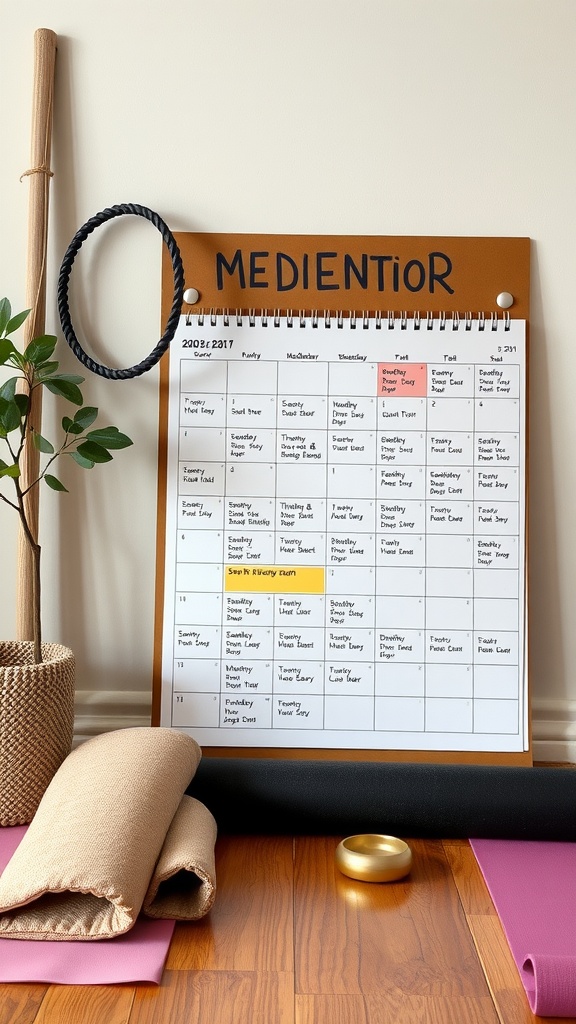
Creating a regular meditation schedule is key to making it a part of your daily life. The image shows a well-organized calendar, which can serve as a great tool for planning your meditation sessions. By visually mapping out your week, you can set aside specific times for practice.
Notice the different activities listed for each day. This variety can keep your meditation practice interesting. You might choose to focus on guided meditations, breathing exercises, or even yoga poses that enhance your meditation experience.
Having a dedicated space for your practice, like a yoga mat or cushions, makes it easier to settle in. In the image, we see soft mats and a calming candle, which can help create a peaceful atmosphere. The little things can make a big difference in how you feel during your sessions.
To get started, try picking a few days each week when you can consistently meditate. Even just five to ten minutes can be effective. As you get comfortable, you can gradually increase the duration. This approach allows you to build a habit without feeling overwhelmed.
Lastly, don’t forget to review your progress. You can use your calendar to note how you felt after each session. This reflection can motivate you to continue and adjust your routine as needed.
Balancing Mindfulness and Stillness
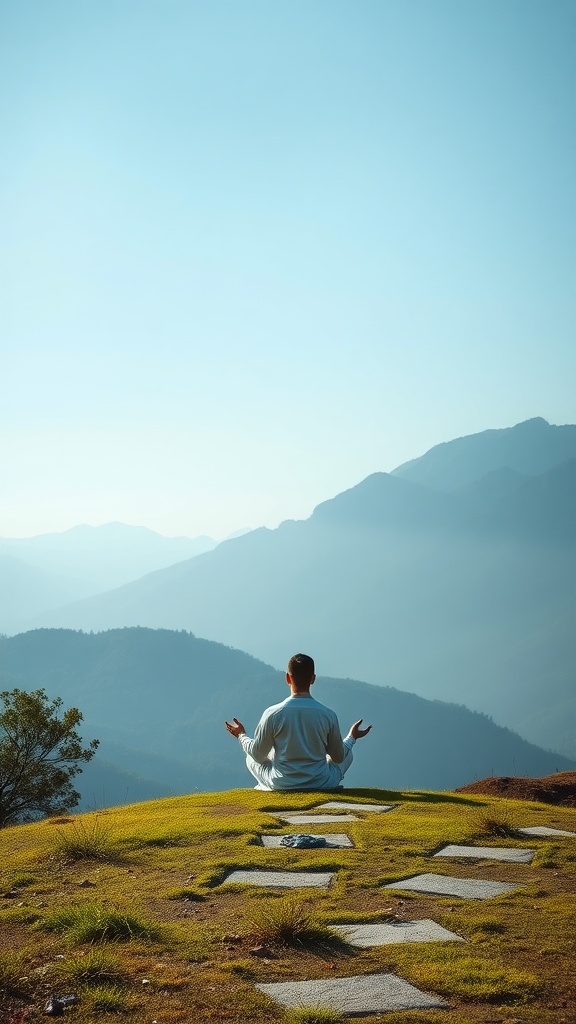
In the image, we see a person meditating peacefully on a grassy hilltop, surrounded by soft rolling mountains. The serene landscape creates a perfect backdrop for yoga meditation, encouraging a deep sense of calm.
Practicing mindfulness during meditation focuses on the present moment. By tuning into your breath and sensations, you invite awareness to settle in. This is essential for balancing the busy thoughts that often cloud our minds.
On the other hand, stillness is about embracing silence and allowing your thoughts to float by without judgment. It’s a gentle reminder to let go of distractions. When you combine mindfulness with stillness, you create a safe space where your mind can relax.
Consider starting your practice in a quiet area, ideally outdoors like in the image. Take a few deep breaths, letting nature’s calm energy fill you. As you meditate, focus on your breath. If thoughts arise, acknowledge them and return your focus to the rhythm of your breathing.
Integrating Visualization Techniques

Visualization techniques can enhance your yoga meditation practice significantly. The image of a person meditating surrounded by a soft glow and gentle patterns captures the essence of this practice. It reminds us that meditation is not just about physical posture but also about creating a mental space that fosters relaxation and focus.
When you sit in a comfortable position, like the individual in the image, take a moment to close your eyes and breathe deeply. Visualize a warm light enveloping you, similar to the aura represented in the picture. This light can represent peace, clarity, or any positive feeling you wish to cultivate during your meditation.
As you continue to breathe, imagine any stress or negativity melting away into the light. This mental imagery can help deepen your meditation experience, allowing you to connect more profoundly with your thoughts and feelings.
Incorporating these visualization techniques into your yoga practice can transform your sessions. It allows you to explore new layers of relaxation and mindfulness, making your time on the mat even more meaningful.
Utilizing Guided Meditation Resources

Guided meditation can be a fantastic way to deepen your yoga practice. When you look at the image of someone meditating outdoors with headphones on, it perfectly captures the essence of using guided resources. The serene environment, combined with focused listening, creates an ideal setting for mindfulness.
Listening to a guided meditation can help you concentrate and ease into the practice. Whether you’re a beginner or experienced, these resources can lead you through various techniques. They often provide calming background music, which can enhance your overall experience.
There are numerous apps and websites that offer guided sessions. Some focus on specific themes, like stress relief or gratitude, while others cater to different durations. This flexibility allows you to find something that fits your schedule and mood.
Remember to choose a comfortable spot, just like the person in the image appears to be doing. Being outdoors can add an extra layer of peace. Nature sounds complement the meditation, making it easier to connect with your thoughts.
So, when you’re ready to practice yoga meditation, consider incorporating guided resources. They can be a helpful companion on your journey to inner peace.
Creating a Peaceful Environment for Meditation
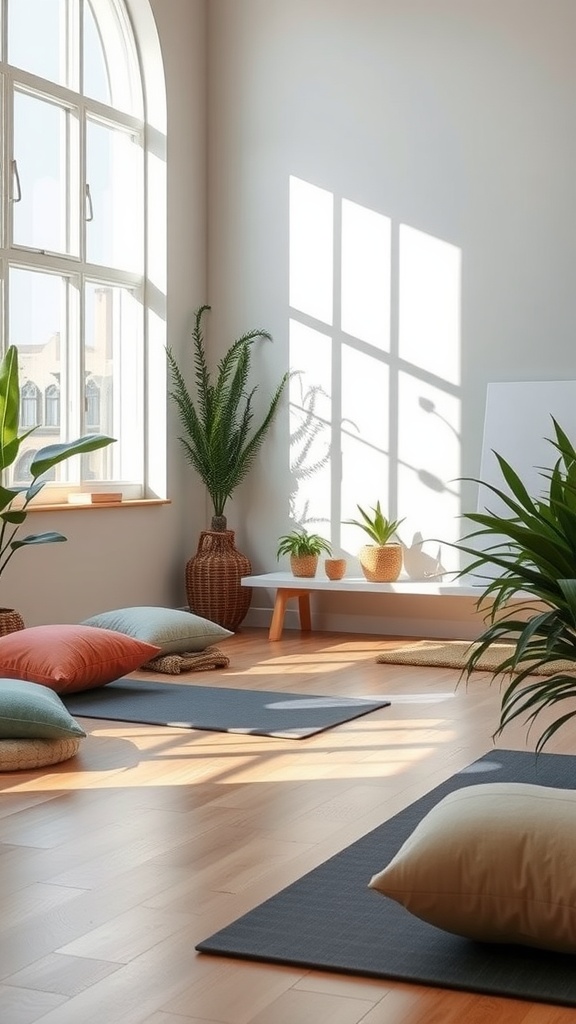
Setting up a calming space for yoga meditation is key to enhancing your practice. The image illustrates a serene room filled with natural light, inviting you to unwind. Notice the soft cushions scattered on the floor, offering a cozy spot to sit or lie down. They add a touch of comfort that encourages relaxation.
The large windows allow sunlight to stream in, creating a warm atmosphere. This natural light can uplift your mood and help you focus during your meditation. Consider positioning your mat near a window where you can feel the sun’s warmth while you practice.
Plants in the room contribute to the peaceful vibe. Greenery not only purifies the air but also connects you to nature, enhancing your mindfulness. Placing a few potted plants around can make your meditation space feel more alive and refreshing.
Soft, muted colors on the walls and the floor create a tranquil backdrop. Choosing calm colors for your space can help reduce distractions and allow your mind to settle more easily. Think about incorporating soothing shades like soft blues or gentle greens.
Lastly, adding personal touches like candles or essential oil diffusers can enrich the atmosphere. The gentle flicker of candlelight or a subtle fragrance can help deepen your meditation experience. Remember, the goal is to create a space that feels inviting and serene.
Exploring Different Meditation Postures
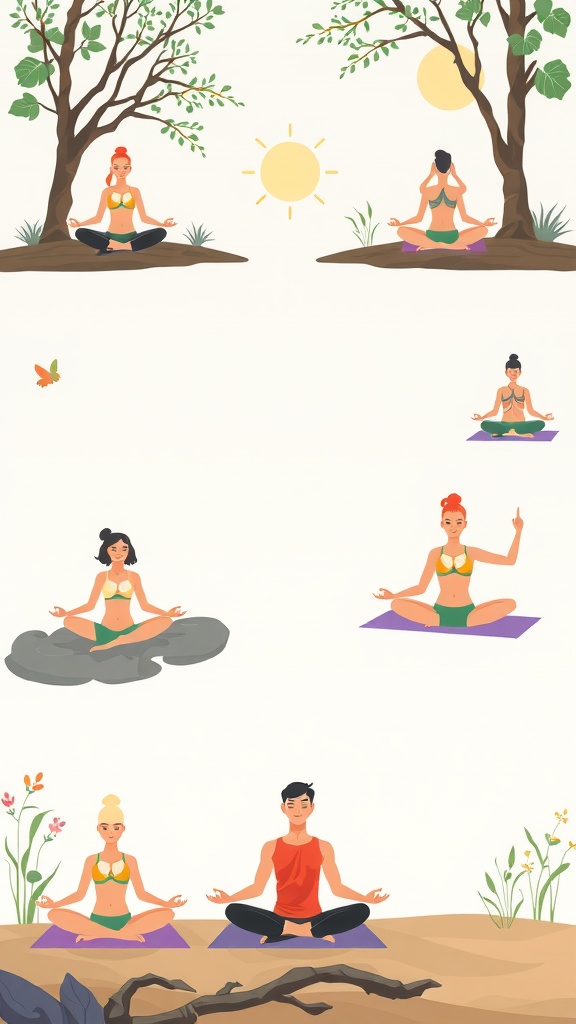
Meditation is all about finding a comfortable place for your mind and body. The image shows various meditation postures that can enhance your practice. Each posture offers unique benefits and can help you connect deeply with your inner self.
The seated positions, like the one with the woman sitting cross-legged under a tree, are popular for grounding oneself. This posture helps maintain stability and focus, making it easier to tune out distractions. You might notice how calm and serene she looks, a great reminder of how meditation can bring peace.
Another posture depicted is the figure sitting on a cloud, representing the idea of lightness and freedom in meditation. This can be particularly useful for those seeking to let go of stress and elevate their thoughts. The gentle touch of nature, like the butterfly nearby, adds to that sense of tranquility.
The image also features a man in a seated position with a relaxed but upright posture. This alignment is essential for effective meditation. Keeping the spine straight allows for better breathing and energy flow, which are crucial for deeper meditation experiences.
Lastly, various surroundings, like flowers and trees, remind us that nature can be a fantastic backdrop for meditation. Finding a peaceful spot outdoors can make a significant difference in how you feel during your practice. Embracing different postures and environments can keep your meditation journey fresh and engaging.
Incorporating Mantras into Your Practice
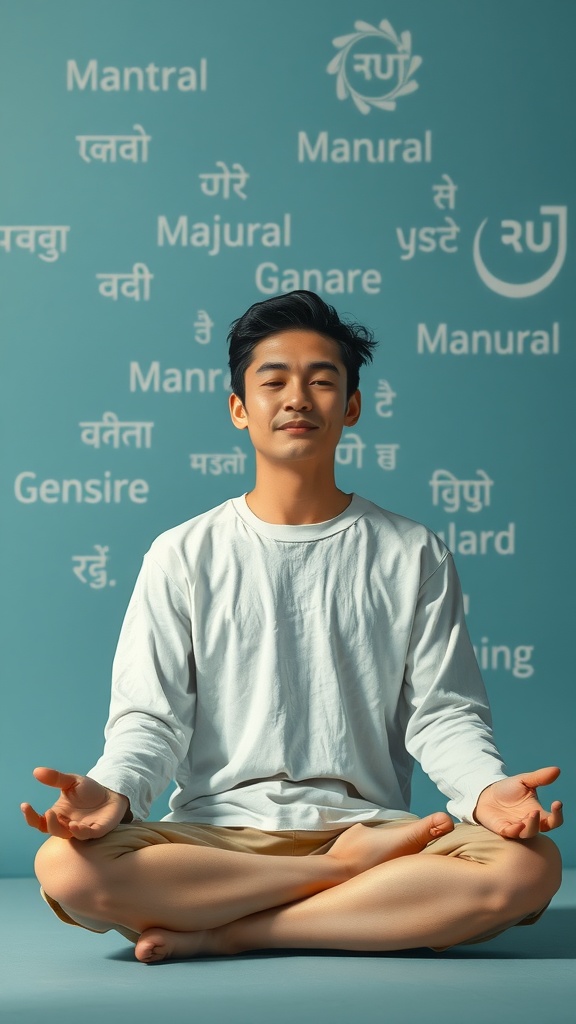
Incorporating mantras into your yoga meditation can deepen your practice and make it more meaningful. The image here shows a person sitting in a meditative pose, radiating calm and focus. The background features various words, hinting at the significance of mantras in meditation. This setting emphasizes the peaceful vibe that mantras can bring.
Mantras are words or phrases that you repeat to help center your thoughts. They can be in any language, but the intention behind them is what matters most. You might choose a simple phrase like ‘I am calm’ or something that resonates deeply with you.
To get started, find a quiet space to sit comfortably. You can either close your eyes or softly gaze at a point in front of you. Take a few deep breaths to settle in. Then, begin to softly repeat your chosen mantra. Allow the words to fill your mind, letting go of any distractions. This can help create a peaceful environment, much like what the person in the image is experiencing.
As you continue, you may notice your thoughts drifting. That’s completely normal! When it happens, gently bring your focus back to your mantra. The more you practice, the easier it becomes to maintain that focus.
Incorporating mantras into your yoga meditation can enhance your experience. It’s a simple yet effective way to cultivate mindfulness and serenity. So, the next time you sit for meditation, consider bringing a mantra along for the ride!
Understanding Breath Awareness Techniques

Breath awareness is a key element in yoga meditation. It helps to anchor your mind and bring your focus back to the present moment. In the image, we see a person who embodies calm and concentration, with her eyes gently closed and a serene expression. This visual perfectly captures the essence of practicing breath awareness.
To start, find a comfortable position, just like the person in the picture. Take a deep breath in through your nose, feeling your chest and belly expand. Then, slowly exhale through your mouth. Repeat this several times. This simple technique can help you tune into your body and release tension.
As you continue, try to notice the rhythm of your breath. Is it fast or slow? Shallow or deep? Observing these details can enhance your mindfulness. The expression of tranquility in the image reflects the peace that can come from simply being aware of your breath.
Another technique to try is counting your breaths. Inhale for a count of four, hold for a count of four, and exhale for a count of four. This structured approach provides a helpful guide to deepen your practice. The gentle smile on the person’s face suggests that breath awareness can also bring a sense of joy.
Remember, it’s normal for your mind to wander. When you notice this, gently bring your focus back to your breath. By incorporating these techniques, you can cultivate a more mindful and peaceful state of being, just like the calm presence seen in the image.
Overcoming Common Meditation Challenges
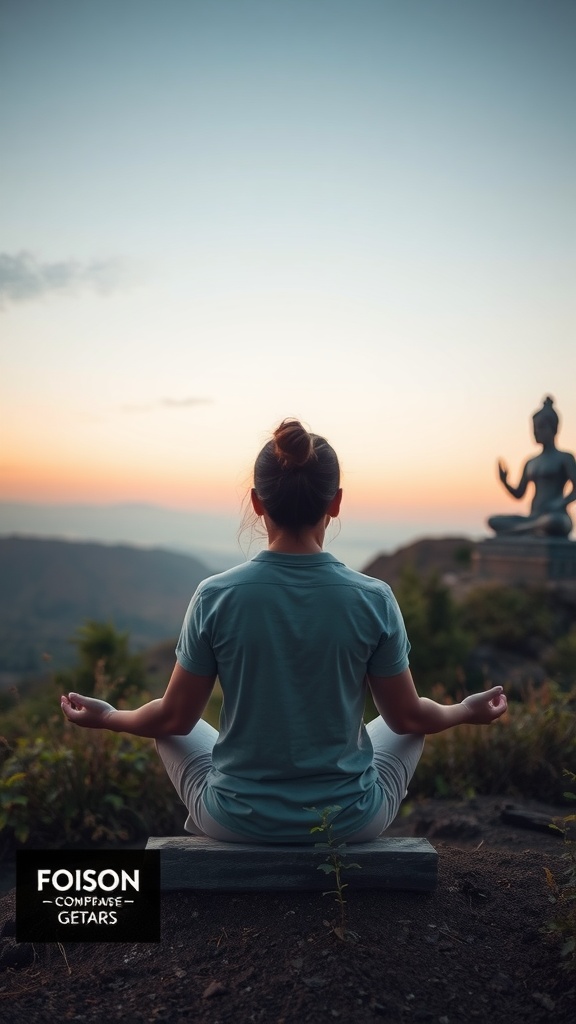
Meditation is often seen as a serene practice, but it can come with its own set of challenges. Just look at the image of a person meditating in nature. The calm surroundings can make it seem easy, but many struggle with distractions.
Finding a quiet space is a big hurdle for many. Whether it’s noise from outside or thoughts racing in your mind, distractions can make meditation tough. One way to tackle this is to create a dedicated space at home. Even a small corner can become your personal sanctuary.
Another common challenge is sitting still. The person in the image appears focused, but not everyone feels comfortable in silence. If you find it hard to sit still, try shorter sessions. Start with just a few minutes and gradually increase the time as you get more comfortable.
Sometimes, people also struggle with what to think about. Should you clear your mind, or is it okay to think about your day? Embrace whatever thoughts come to you, and gently guide your focus back to your breath. Remember, it’s all part of the journey.
Lastly, remember that meditation isn’t a competition. Each person’s experience is unique. Celebrate the small victories, like simply showing up for yourself and making time to meditate.
Embracing the Journey of Self-Discovery
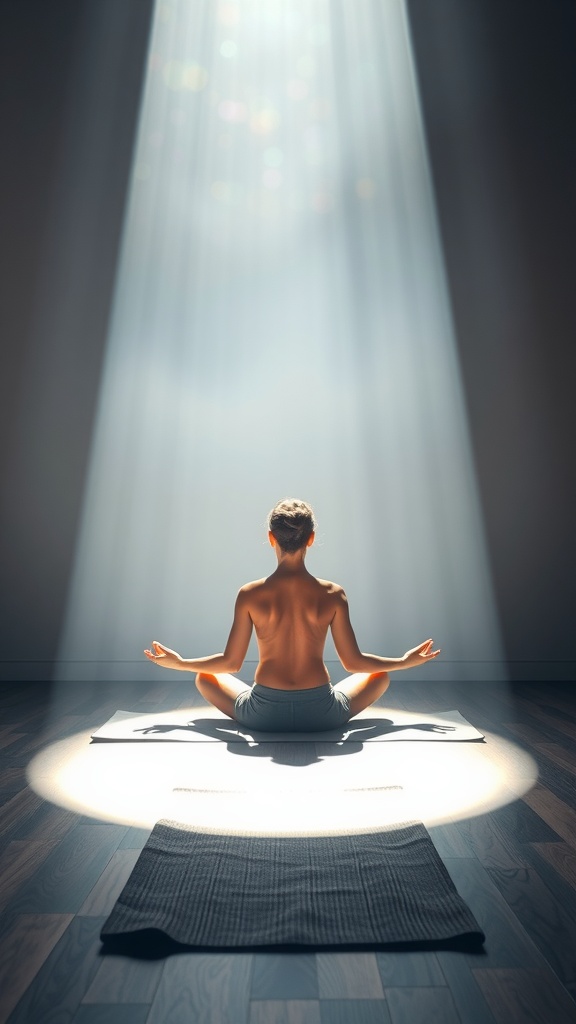
The image captures a serene moment in a yoga meditation practice. A person sits cross-legged on a mat, facing away, with their arms gracefully positioned. The gentle rays of light streaming down create a peaceful atmosphere, inviting reflection and calmness.
Practicing yoga meditation is not just about physical postures; it’s a journey into self-discovery. Each session can offer insights into your thoughts and emotions. As you find a comfortable position, like the one shown in the image, you begin to connect with your inner self.
Embracing this journey means accepting where you are today. Some days, you might feel energized and focused, while other days may bring distractions. Both are part of the process. The important thing is to show up, just like the individual in the image, and allow yourself to be present.
During your practice, focus on your breath. Notice how it flows in and out. This simple act can ground you and enhance your awareness. As you meditate, you may find insights arising naturally, guiding you to discover more about your thoughts and feelings.
With time, you might notice shifts in perspective. Your meditation space, like the one depicted, can become a sanctuary. It’s a place to explore, reflect, and grow. Embrace each moment in your practice, knowing that each step is valuable in your journey of self-discovery.